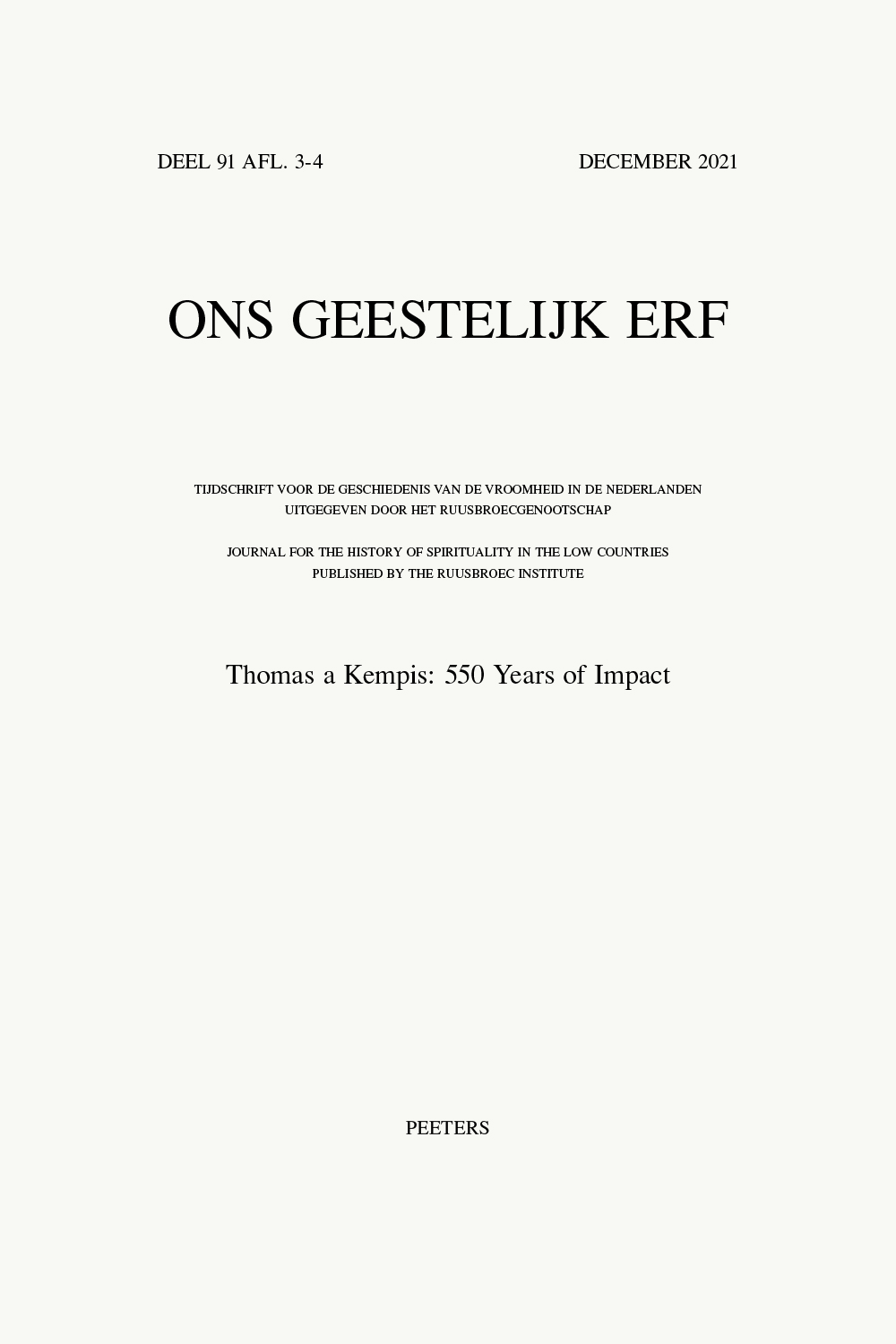 previous article in this issue previous article in this issue | next article in this issue  |

Preview first page |
Document Details : Title: The Modern Devout and the Inquisition Author(s): GOUDRIAAN, Koen Journal: Ons Geestelijk Erf Volume: 89 Issue: 1 Date: 2018 Pages: 50-91 DOI: 10.2143/OGE.89.1.3285126 Abstract : This article investigates the opposition to the nascent Devotio Moderna during the last decade of the fourteenth century. Its main arguments are (1) that despite the fact that during two episodes inquisitors took some action against the new movement, opposition against the Devout as a whole was discontinuous and (2) that there was no linear development from opposition against the movement through legal defense towards ecclesiastical recognition, but that the process was rather erratic. This new analysis was occasioned, among other things, by the revised chronology of inquisitorial appointments, published by Michael Raley in this same periodical (2012). As no new sources have become available recently, a fresh start can be made only by a preliminary analysis of the paradigm of ‘threat and protection’ dominating scholarship on this episode: threat of the Brethren and Sisters by the mendicants and protection of them by the regular canons of Windesheim. The first two sections of the article, therefore, analyse the vagaries of the debate conducted since the middle of the nineteenth century concerning the New Devout and their enemies at the turn of the fifteenth century. The initial stages of this debate were influenced by confessional loyalties, with liberal Protestants in the forefront and Catholics reacting against them. Factors playing a role were the tendency of historians such as Moll to consider the Devout, and especially those living together without vows, as the progressive and ‘national’ forces in late medieval history, as opposed to the ‘reactionary’ mendicants, and the connection that could easily be made between the members of the mendicant orders and the inquisition. A congenial witness was found in Johannes Busch, the great historian of the Devotio Moderna. Busch construed three episodes in the life of Geert Grote in such a way that they underscored the aforementioned ‘threat and protection’ paradigm. In two separate stages of the modern debate, Van den Borne (1940-42) and Lesser (2005) have contributed to the deconstruction of the ‘myth of Windesheim’. In the present article, this line of inquiry has been pursued further. As it appears now, the paradigm of ‘threat and protection’ started early in Modern Devout circles, indeed: in the 1420s. But it cannot be found before. In the remainder of the article, the sources contemporaneous to the events of the 1390s are studied. They fall apart in two categories, the Acts of the Inquisition and the consilia (legal advices). Though the two types of documents have been included together in Fredericq’s Corpus Inquisitionis, they are studied here separately. In the first category belong two documents (Fredericq II, 106 and 114), called here documents ‘A’ and ‘B’. They are analysed from the points of view of date, transmission, formal structure and content. Both documents consist of an original nucleus and a later addition, the first stemming from the original inquisitorial action itself. Analysis of the contents of these original parts suggests that they belong to the same incident, in which the sisterhouses of Utrecht and Rhenen were the target. This result partly contradicts the findings of Raley, who assigned document ‘A’ to an early date in the 1390s, document ‘B’ to a late one, viz. summer 1399 at the earliest, because that is the date he found for the appointment of Eylard Schoneveld as inquisitor. It is proposed now that both documents emanated from the office of Eylard and so cannot be dated before mid-1399. This means that they postdate the consilia and also the magnum negotium of 1398 and the decision to adopt the Third Franciscan Rule of Easter 1399. Next, the legal advices (Fredericq II, 107-113 and some texts not included by Fredericq) are studied one by one, with the focus on the clues they offer to the specific circumstances under which they were elicited. This results in the drawing up of a list of six separate moments of opposition, the last two of which involved the threat with resp. the reality of an inquisitorial investigation. One of the issues discussed in this section is the question whether, together, the consilia once constituted a ‘dossier’ serving in a process before the bishop’s court. This has been suggested by John Van Engen in the third chapter of his Sisters and Brothers of the Common Life. The answer given is negative, because of the fact that they fit neither the content nor the date of the only inquisitorial procedure we have sure knowledge of. In the final section the approbation of the non-monastic branches of the Devotio Moderna is discussed briefly. Recognition of separate houses started already in the 1380s. It was crowned by the recognition of the transfer of an important number of houses to the Third Rule of Francis, followed by the foundation of the Chapter of Utrecht (1399-1401), and the licence to the sister- and brotherhood in 1401. The devout had succeeded in building up a good relationship with the hierarchy and in assembling a network of learned acquaintances. These counterbalanced, to say the least, the oppositional forces such as the disfavour of the inquisitor. In the clauses of the approbations, some elements of the consilia reappear. Traces of the inquisitorial episode are absent. |
|


